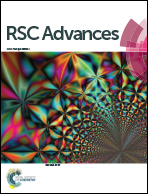The role of soft colloidal templates in the shape evolution of flower-like MgAl-LDH hierarchical microstructures†
Abstract
A flower-like MgAl layered double hydroxide (MgAl-LDH) hierarchical microstructure was synthesized by a self-assembly route, employing the anionic surfactant sodium dodecyl sulfate (SDS) as a soft template. X-ray diffraction, Fourier transform infrared spectroscopy, thermogravimetric analysis and Brunauer–Emmett–Teller analysis were employed to characterize the samples. Structural characterization revealed that the hierarchical microstructure materials are composed of nanosheets with a thickness of about 50 nm with a hierarchical porous structure with both large and small mesopores on the surface. The average diameter and specific surface area of the hierarchical porous microstructures were 1.544 nm and 41.20 m2 g−1, respectively. Furthermore, it was found that the diameter and density of the three-dimensional (3D) hierarchical microstructures could be varied by changing the growth parameters, such as growth time, growth temperature, initial reactant concentration, and surfactant type. Compared with two other surfactants, the anionic surfactant sodium lauryl sulfate (SLS) and the cationic surfactant cetyl trimethyl ammonium bromide (CTAB), the anionic surfactant SDS plays dual roles as both a capping agent and through its intercalation in controlling the shape of the MgAl-LDH hierarchical microstructure. Based on the analysis of the evolution of the microstructure and crystalline structure of the MgAl-LDHs, a corresponding formation mechanism of the three-dimensional hierarchical microstructures was proposed. In addition, the thermal stability of the as-prepared hierarchical microstructures of the MgAl-SDS-LDHs was further evaluated. The results show that MgAl-SDS-LDH can be preserved up to 500 °C and eventually be transformed into spinel MgAl2O4 with a similar hierarchical microstructure, indicating the high thermal stability of the hierarchical microstructure.


 Please wait while we load your content...
Please wait while we load your content...